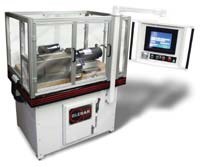Sliding Headstock Applied To Micro-Grinding
In the world of machining very small parts, what you get isn't necessarily what you can see. Many of the parts being manufactured for medical, electronics and aerospace are too small to be accurately discerned by the human eye.
Share





In the world of machining very small parts, what you get isn’t necessarily what you can see. Many of the parts being manufactured for medical, electronics and aerospace are too small to be accurately discerned by the human eye.
That lack of visual reference hasn’t stopped the development of a machining niche for prototype and production grinding workpieces from wire stock. It’s a growing segment of the precision machining market.
For many years, Swiss-type lathes have been successfully used to turn very small parts for the watch industry. By using a sliding headstock for longitudinal movement, with a guide bushing for support, parts with high length to diameter ratios can be machined.
Key to this technology is the position of the cutting tool relative to the face of the headstock, which contains the guide bushing. The cutters move perpendicular to the workpiece and engage it as it emerges from the guide bushing.
Cutting forces are therefore focused on the most supported point of the workpiece. Traversing the work across the cutters, using the moving headstock, allows long thin shafts to be machined without deflection.
This same concept of the moving headstock has been applied to a new grinding machine developed by Glebar, Inc. (Franklin Lakes, New Jersey). Called the model CAM SXE-B, it is designed to produce custom parts from wire stock with projecting features, flats and other geometric forms that were traditionally created using multiple machining steps across several machine tools. The working range for this machine is 0.125 to 0.002 inch diameter wire stock. Unlike conventional centerless grinding processes, which can impart profiles only within the width of the grinding wheel, this new design is able to machine unrestricted profile lengths.
Targeted initially at the medical industry, the new machine is designed to increase the precision and flexibility of producing standard and custom guidewires used for a variety of minimally invasive surgical procedures. The use of CNC on all machine axes makes setup of production volumes of higher precision standard guidewires and prototypes significantly faster than other processes.
For short run and prototype work, the designer simply draws the wire profile at a CAD station then downloads it to the machine. Any necessary edits can be performed at the machine. According to the company, a part can be running in minutes.
Glebar’s machine is a full CNC six-axis grinder. The wheel head carries a 12-inch diameter grinding wheel with superabrasive capability, if dictated by the workpiece material. Wheel widths from 0.010 inch to 1 inch can be accommodated. A machine mounted, two-axis CNC dresser can profile the grinding wheel in process for plunge grinding or dress the wheel straight for traversing.
The headstock holds the workpiece in a collet system and has linear in-feed (toward the grinding wheel) and C-axis rotary axes capabilities. Its speed range is 0-5,000 rpm. The work can be rotated against the grinding wheel or held stationary for OD work.
In the centerless operating mode, a regulating wheel is located across from the grinding wheel and acts as a steady rest to provide additional support for the workpiece. This setup helps the machine achieve its accuracies and productivity on very thin wire. Length accuracy, in the centerless mode, is 0.001 inch with diameter accuracy of 0.0001 inch.
As applications within the medical, aerospace, electronic and other industries demand higher production, lower costs and tighter tolerances, a look at this new grinding machine and process should be considered.
Read Next
Registration Now Open for the Precision Machining Technology Show (PMTS) 2025
The precision machining industry’s premier event returns to Cleveland, OH, April 1-3.
Read MoreBuilding Out a Foundation for Student Machinists
Autodesk and Haas have teamed up to produce an introductory course for students that covers the basics of CAD, CAM and CNC while providing them with a portfolio part.
Read More5 Rules of Thumb for Buying CNC Machine Tools
Use these tips to carefully plan your machine tool purchases and to avoid regretting your decision later.
Read More


























.png;maxWidth=300;quality=90)





